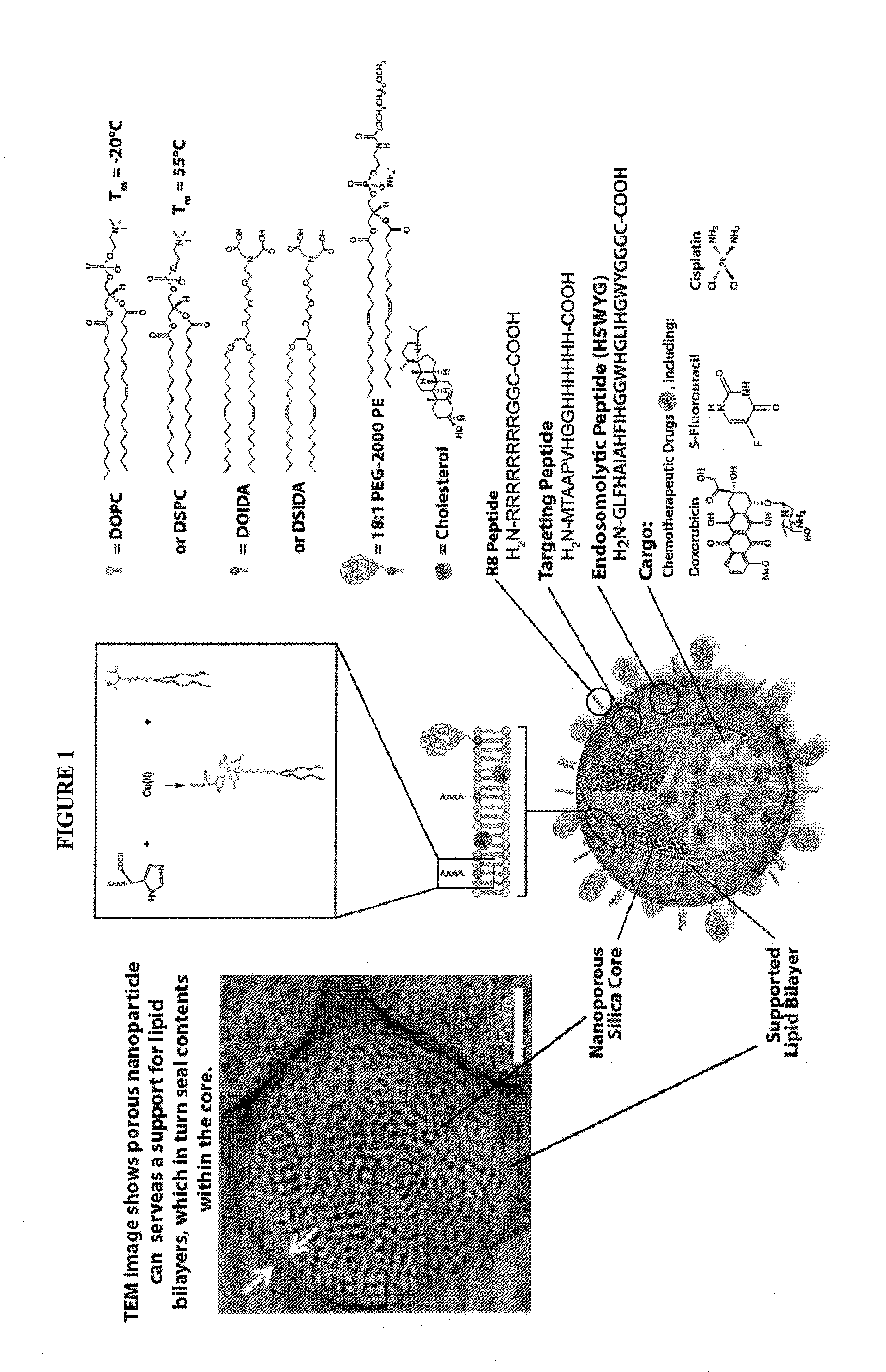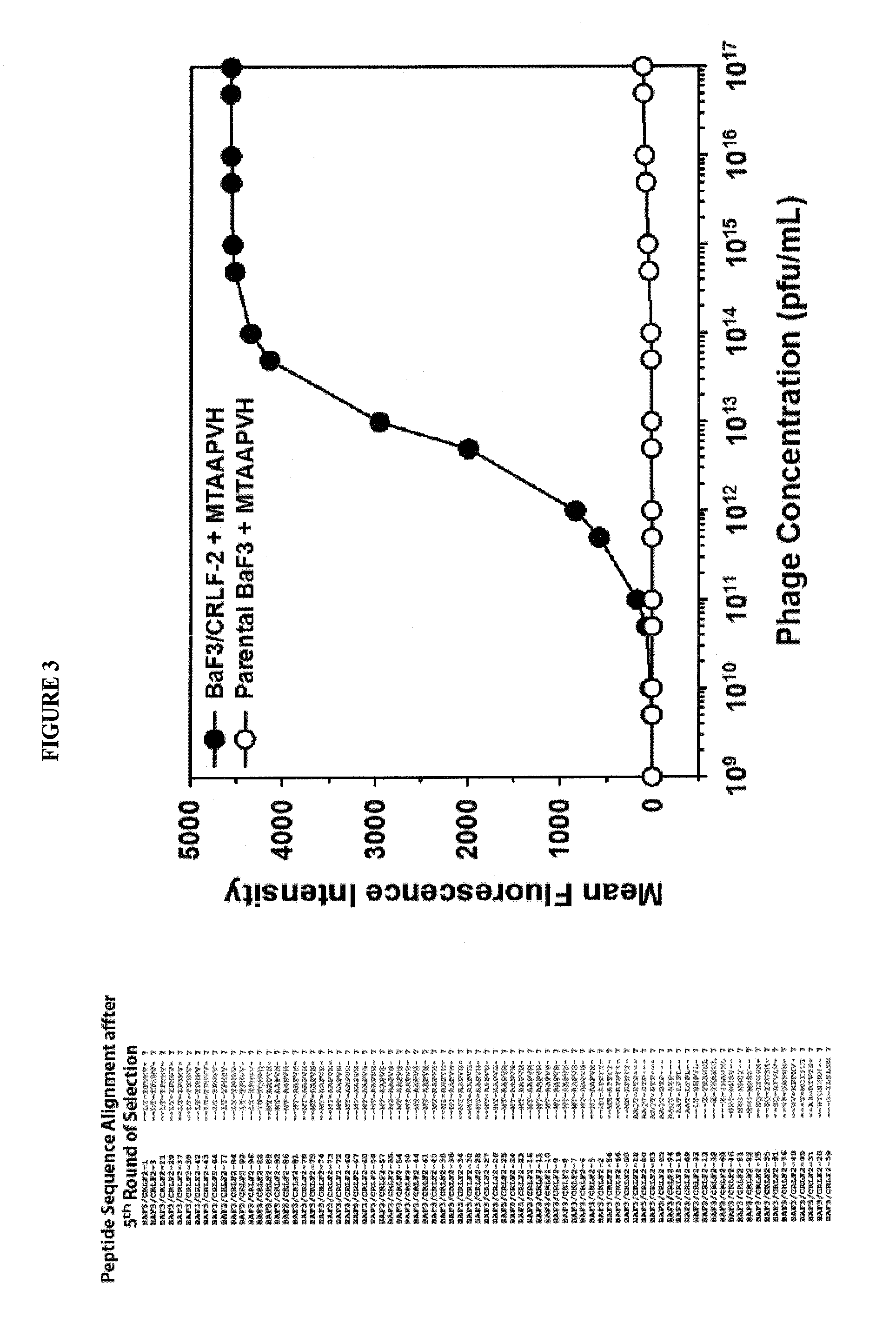Crlf-2 binding peptides, protocells and viral-like particles useful in the treatment of cancer, including acute lymphoblastic leukemia (ALL)
a technology of protocells and crlf2, which is applied in the direction of peptides, dna/rna fragmentation, drug compositions, etc., can solve the problems of severe limitations in the therapeutic potential of many classes of macromolecules, especially nucleic acids and proteins, and the death of remission. , to achieve the effect of easy modification of surface chemistry, high surface area and readily variable porosity
- Summary
- Abstract
- Description
- Claims
- Application Information
AI Technical Summary
Benefits of technology
Problems solved by technology
Method used
Image
Examples
example 1
Protocells and VLPs as a Potential Treatment for ALL
[0292]Here we report the use of protocells and VLPs as a potential treatment for ALL, as well as other cancers. We have identified peptides that effectively bind CRLF-2, a receptor that has been found to be over-expressed in ALL, allowing for effective preferential targeting of the protocell to leukemic cells. This has been accomplished by affinity selection against either recombinant CRLF-2 or BaF3 cells that were transfected to over express CRLF-2. A variety of drugs has also been delivered to the cells, including (high potency, high toxicity) or AG490 (low toxicity, low potency). The in vitro results suggest that protocells are several order of magnitude more effective at combating this leukemia than free drugs alone. In-vivo experiments using SCID mice injected intravenously with BaF3 / CRLF2 cells are currently underway.
Protocell—Flexible Platform for Targeted Delivery
[0293]TEM image shows porous nanoparticle can serve as a supp...
example 2
CD19 Protocol
[0343]CD19 IgG1 was partially reduced via reaction with a 60-fold molar excess of TCEP for 20 minutes at room temperature. Reduced antibody was then desalted and incubated with protocells (DOPC with 30 wt % cholesterol and 10 wt % maleimide-PEG-DMPE) overnight at 4 C. Protocells were washed 3× with PBS before being added to cells.
[0344]For flow cytometry experiments, particles were labeled with Alexa-fluor-647 and incubated with various cell types for an hour before the samples were washed and immediately measured using a FACSCaliber flow cytometer (data shown in FIG. 16). Samples included both targeted VLPs (displaying the targeting peptides identified via phage display) and nontargeted VLPs (displaying a non-relevant peptide and particles not displaying any additional peptides). These particles were screened against both BaF3 / CRLF-2 and parental BaF3 cells. As expected, none of the samples demonstrated significant binding other than the targeted VLPs incubated with ta...
example 3
N2.v.1 ALL—a Model System to Understand and Perfect Targeted Delivery
[0345]Diagnostic leukemic blast samples were obtained from 207 ALL patients enrolled in Children's Oncology Group (COG) trial 9906. These children had characteristics (older age and higher white blood count) that suggested that they were at an elevated risk of relapse (44% event free survival in earlier trials). RNA was extracted. Biotinylated cRNA was synthesized and hybridized to HG_U133A_Plus2.0 oligonucleotide microarrays, and fluorescent intensity signals were obtained for 54,688 probes sets corresponding to named genes and uncharacterized transcript). Final intensities were obtained after a standard masking and normalization procedure. “Outlier” genes, defined as transcripts expressed several logs above or below the mean in a subset of samples were identified by a variation of a COPA analysis and unsupervised hierarchical clustering was performed (FIG. 17(a)) Even in the absence of information concerning pati...
PUM
| Property | Measurement | Unit |
|---|---|---|
| diameter | aaaaa | aaaaa |
| diameter | aaaaa | aaaaa |
| diameter | aaaaa | aaaaa |
Abstract
Description
Claims
Application Information
 Login to View More
Login to View More - R&D
- Intellectual Property
- Life Sciences
- Materials
- Tech Scout
- Unparalleled Data Quality
- Higher Quality Content
- 60% Fewer Hallucinations
Browse by: Latest US Patents, China's latest patents, Technical Efficacy Thesaurus, Application Domain, Technology Topic, Popular Technical Reports.
© 2025 PatSnap. All rights reserved.Legal|Privacy policy|Modern Slavery Act Transparency Statement|Sitemap|About US| Contact US: help@patsnap.com



